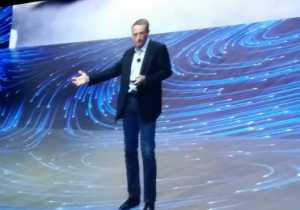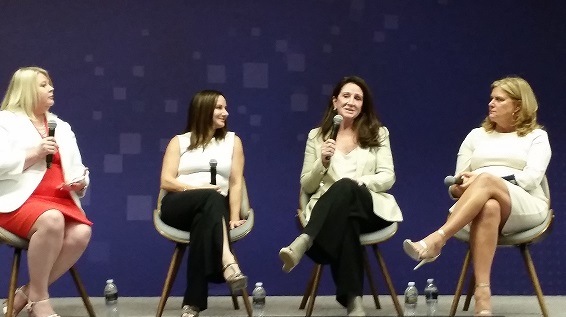VMware dazzled with a plethora of ‘Projects’, previews and platform updates at its annual user conference in Las Vegas last week. But what is driving of this inflation of the inner bubbling? One answer lies in the exponential rate of change that marks the ICT landscape today: while disruption of traditional industries continues through the relentless advance of digitization, the development of new technologies whose ultimate impact remains the stuff of science fiction are demanding a response from vendors and users alike. By 2045, futurist Ray Kurzweil predicts that the acceleration of technological innovation will result in singularity, the point at which machines are smarter than human beings. Some time before that, a failure of intelligence will spell the collapse of technology adoption laggards due to pressures from more enlightened competitors.

This heady atmospheres spells both challenge and opportunity for existing providers. For VMware, which celebrates its 20th anniversary this year, it calls on the company to demonstrate an understanding of the fundamental shifts that are underway in the marketplace, but also the ability to help its customers negotiate, and indeed profit from this innovation. In his keynote address to 20,000+ attendees to VMworld 2018, CEO Pat Gelsinger defended VMware’s reputation as an innovator by celebrating the company’s decade’s long history of “Bridging across silos of innovation,” while plugging new initiatives in key emerging areas. VMware’s list of “Projects” announced at the event, reads like a Who’s Who of the emerging technology set:
Project Magna – or “the self-driving data center” relies on reinforced learning in the data center environment to improve performance and efficiency. The solution applies AI and machine learning to data contained in application code, or data generated by software and hardware infrastructure, including the public cloud, to better understand application behavior. Data is then used to model, test, and reconfigure the network for optimal performance.
Project Concord – a VMware open source project aimed at the creation of a scalable, energy-efficient decentralized trust infrastructure for digital consensus and the execution of smart contracts. In other words, technology designed for the support of distributed trust infrastructures, such as Blockchains.
Project Dimension – a ‘technology preview’ designed to extend VMware Cloud capabilities to the data center, to branch offices and to the edge. The project combines VMware Cloud Foundation (vSphere + vSAN + NSX + management) in a hyperconverged form factor with VMware Cloud managed services to deliver software-defined data centre infrastructure as an end-to-end service, operated by VMware.
VMware Pulse IoT Center 2.0 – VMware’s announcement on IoT is a platform update that aims to provide additional support for edge devices via broader management capabilities, more intelligent operation and enhanced security. The goal is to enable customers to scale to hundreds of thousands of devices through SaaS – or managed services delivery formats.

Though they occupy different points on the innovation spectrum, AI/ML, Blockchain, IoT and edge computing may all fairly be viewed as key emerging technologies that will have significant impact on the operation of IT, and indeed, drive the transformation of whole industries. In the VMware pantheon, they represent “incubation” or research areas. As Rajiv Ramaswami, COO products and cloud services for VMware, explained at the event, the company has developed a structured approach to the management of R&D, which groups its portfolio into five buckets: pre-incubation by small teams with concepts that may ‘fail fast’, the incubation of new products, products with good marketing in place that can readily scale to a large business, mature solutions that need to be managed efficiently to drive profitability, and products that are not doing well that need to be divested. “We have a very rich pipeline at the bottom level of the funnel,” he added, though “a lot of ideas don’t get past that gateway – the incubation stage.” Interestingly, a good deal of attention was trained at VMworld 2018 on these areas, which do not currently generate revenues that are material to VMware’s business as a whole – specifically, the “Projects” or emerging technology areas that Ramaswami categorized as incubation initiatives. (many of the Cloud services announcements made at the event relate to scale products, even though some do not generate revenues that align with their relative investment; vSphere would be a mature product; and ‘Projects’ are at the incubation stage).
Computing at the network edge

This focus on new technologies is presumably designed to reinforce VMware’s reputation as an innovator. Edge computing, on the other hand, is the exception that proves the rule – an emerging area to which VMware has devoted considerable R&D, while mustering traditional capabilities and market investments in existing, or “scale” products and services. According to Raghu Raghuram, VMware COO, products and cloud services, broad activity on the edge front reflects the strategic nature of this area for VMware, as what the company learns developing products and services for the edge will have implications for cloud and software-defined data centre offerings going forward. At VMworld 2918, the company made several announcements which attest to its perceived need to develop positioning in this space. With a goal of ‘extending’ its hybrid cloud digital foundation from cloud to the edge, VMware has made investments across the portfolio: Kit Colbert, VP & CTO, VMware’s cloud platform business unit, has aligned VMware innovation and existing product capabilities with three key edge requirements:
Edge device management – in edge deployments, human device (smartphones, laptops, tablets) needs can be addressed via Workspace ONE, the company’s enterprise mobility management platform. IoT devices will be managed through the Pulse IoT Center IoT 2.0 infrastructure management solution, a managed services offering hosted by VMware and VCPP partners, which includes RESTful APIs to enable application innovation and partner integrations. To deliver simplified management, greater control and enhanced security, Pulse v. 2 features low-touch enrollment and configuration capabilities, the ability to perform Gateway configuration through the action framework (sshd, turn on/off port, IP address table, etc.) and provide complete firmware and BIOS updates for selected gateways, the delivery of alert notifications on individual managed objects or a group of objects via email and SMS integration or APIs connecting into a third-party systems, and more granular control of OTA (over over-the-air) scheduling, activation, progress status, package type and failure handling. As Mimi Spier, VP, Internet of Things, VMware, explained, “VMware Pulse IoT Center 2.0 was designed to help customers harness their data at the edge while providing the vital infrastructure and operations needed for a consistent, more secure and open digital foundation for innovation.”
The compute edge – aimed at delivering data centre class server requirements, Project Dimension plays at the compute edge. An amalgam of capabilities developed across VMware’s compute (vSphere), storage (vSAN) and networking (NSX) portfolios, Project Dimension encompasses two primary components: VMware’s Cloud Foundation platform for on-premises edge and datacenter locations, which combines with optimized (partner DellEMC and Lenovo) hardware to deliver a lightweight HCI appliance. A second piece, according to Colbert, is a unified Hybrid Cloud Control Plane that runs as part of VMware Cloud’s SaaS service, allowing VMware to monitor all Project Dimension infrastructure locations for problems – and proactively fix them – while delivering infrastructure software and firmware upgrades and patches.
The network edge – VMware ability to extend the NSX virtualized networking platform from cloud to the edge has been enhanced through SD-WAN capabilities brought to the company through the acquisition of VeloCloud. Pat Gelsinger described this cloud-delivered SD-WAN as the “hottest product in our portfolio.” Leveraged by Project Dimension, VeloCloud enables connectivity with other regions – between the edge, data centre or cloud.
Driven by IoT in massive use cases like autonomous vehicles, and enabled by containerization that supports local innovation, edge computing market growth now conveys an urgency that traditional vendors neglect at their peril. As Gelsinger noted, “the world is moving from data centres to centres of data” – an observation that was reinforced by Dell Technologies CEO Michael Dell in a VMworld 2018 press conference: “We see a pretty massive build out on the edge that is related to billions of connected devices. While some of that data will be aggregated back to data centres – in distributed or in mega clouds – increasingly, what you will see with 5G is node-to-node communications, and new kinds of applications that are developed on the edge. If you plot this out, and think about how much data will there be, and how many connections there will be, the edge will be quite a bit larger than any of the stuff that exists today in what you think of as the public cloud, or private cloud.” Michael Dell’s 5G “node to node communications” suggests a distributed paradigm in which the majority of data will not traverse traditional networks; however, he remained confident that “servers are not going anywhere soon,” and will be needed for the foreseeable future as the as yet unknown “huge diversity of IoT and edge use cases” that will appear will continue to create additional demand.
Michael Dell’s position on IoT and edge is not new: as CEO of a leading provider of distributed devices and hardware (the PC, an established IoT gateway portfolio, servers), Dell is a long-term promoter of the IoT future. But what of VMware, which has devoted much of its 20-year history to innovation around the consolidation, abstraction and centralized management of cloud-based assets? At least part of VMware’s genius lies in its adaptability, in its ability to coopt the latest swing of the industry’s centralized/distributed architectural pendulum by tailoring existing IP to the latest (edge) technology archetype.
Old wine in new bottles?
VMware’s long-standing status as a leading provider of on-premise data centre solutions was reinforced several times at VMworld 2018 as the company positioned as the “leading private cloud provider” to partner AWS’ stance as the “leading public cloud provider.” However, though the simple delivery of existing capabilities for local data centre would play to VMware traditional strengths, this approach is not adequate for addressing the new requirements of the instrumented world. Commenting on differences between traditional DC and edge needs, Ramaswami explained, “There are a couple of big changes. The first is the scale at which these edge nodes will be deployed – the need will be much greater than it was for the traditional [enterprise] branch. And while this remote office/campus market will continue to exist as an edge use case that is also being modernized, there is a new edge that is emerging – an automotive edge or industrial/manufacturing edge – featuring new applications with much larger scale than the branches. A second change is the way that infrastructure is managed because scale will require more automation as IT workers look to avoid manual infrastructure management in favour of tasks aimed at creating additional business value.” These new needs, he argued, create opportunity for projects like Dimension, which tries to simplify the process of managing infrastructure out at the edge. “We take that on as a cloud-delivered service at scale,” he added, “because you are going to have a lot of nodes and edges, which are functionally doing the same thing and can be managed in a homogeneous way from a single point of control.”
Another change, one could argue, lies in the challenge posed by the need for new applications and use cases. In fact, in a presentation on 5G, Unlocking the Potential of IoT, with Mimi Spier, Honore LaBourdette, VMware VP NFV and Chris Wolff, head of global OEM and IoT partnerships, DellEMC, panelists concluded that the technology is now available for the deployment of robust IoT; however, the development of use cases that can readily demonstrate business value continue to lag at the enterprise level. DellEMC and VMware (and others) are working to address this – through applications developed in the IoT ISV partner ecosystems, through preconfigured solutions, such as the Dell Technologies IoT Solution for Surveillance, a bundled solution that includes the Pulse IoT Center and VMware’s SDDC for gathering and analyze data at the edge, announced at the event, and, as Spier noted, in the creation of architectural blueprints designed for specific vertical stacks.

Telco modernization
A good example of this verticalized innovation can be found in the telco space, which Gelsinger likened to a greenfield opportunity – “only 10 percent of telco networks are virtualized,” he claimed – and which has received attention from VMware commensurate with potential opportunity. According to Honore Labourdette, VMware has worked to develop its telco offerings at three different levels: with solutions to modernize IT operations, to virtualize core networks, and to support creation of new telco services. She identified IT as one “centre of transformation,” where VMware is helping telcos to move towards private cloud and software-defined infrastructure or to leverage public cloud for test/dev and other applications.
A second centre of transformation lies in the application of VMware’s network virtualization solution (vCloud for NFV platform, which includes vSphere, NSX, vSAN and management tools) to solve NFV challenges, and enable the delivery of telco network services. To address the needs of large complex networks, VMware has optimized the performance of its NSX switch to ensure that services will not experience degradation through work with Intel to add a DPDK (Data Plane Development Kit) function in the switch that improved performance by a factor of five. It also offers two virtualized infrastructure management distributions – an open stack distribution for network functions, and the VMware vCloud Director as a VIM, including APIs for management and orchestration to enable third-party applications to run on the VMware platform. With vCloud for NFV, VMware also delivers a reference architecture to support the creation of network services, which includes release management, and certifies that the operation of network services will work equally well in a virtualized environment as in a hardware environment.
Business services constitute a third centre of transformation, which has benefited from the VeloCloud acquisition of SD-WAN capabilities. “Here’s what’s really interesting and differentiated about VMware in its work with the telcos,” Labourdette added. “This virtualization infrastructure can span across all three of those centres of transformation as the same platform so that the customer can leverage existing assets to do all of the things they need to do.”
Labourdette believes that virtualization is critical to the roll out of 5G networking, which is touted as the precondition for mass penetration of IoT. She cited Pat Gelsinger’s observation at MWC 2017: “There will be two types of 5G networks – the ones that are built on NFV and the ones that fail,” to ponder whether telcos can compete meaningfully in an IoT world without the flexibility and management that network virtualization can deliver. While the telco space represents a special case – and indeed its own argument for the coming importance of edge computing – these same claims for the criticality of flexibility, management and open systems can be made across verticals. The question is, who can deliver this more quickly, more cheaply, and more reliably? The pace of IT innovation, open collaboration and the greater ease with which startups can enter the market today mean that this issue is not so easily resolved as it might have been a decade ago. But the ability to deliver a breadth of services that are optimized to work together, and apply these to new and emerging applications described above – but developed over two decades of development activity – may be the ace in the hole.








